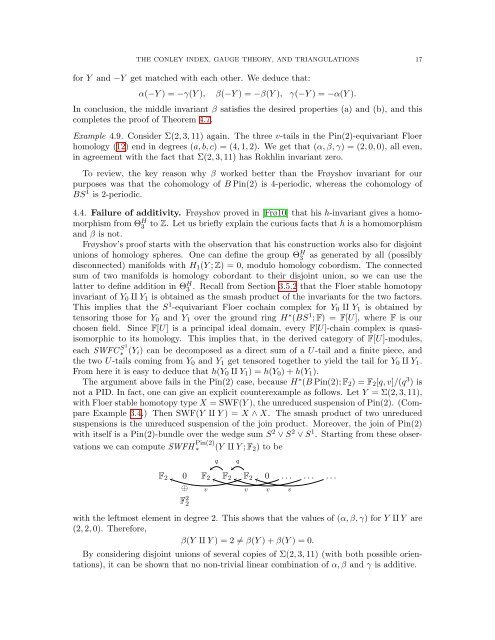The Conley index, gauge theory, and triangulations - UCLA ...
The Conley index, gauge theory, and triangulations - UCLA ...
The Conley index, gauge theory, and triangulations - UCLA ...
Create successful ePaper yourself
Turn your PDF publications into a flip-book with our unique Google optimized e-Paper software.
THE CONLEY INDEX, GAUGE THEORY, AND TRIANGULATIONS 17<br />
for Y <strong>and</strong> −Y get matched with each other. We deduce that:<br />
α(−Y ) = −γ(Y ), β(−Y ) = −β(Y ), γ(−Y ) = −α(Y ).<br />
In conclusion, the middle invariant β satisfies the desired properties (a) <strong>and</strong> (b), <strong>and</strong> this<br />
completes the proof of <strong>The</strong>orem 4.7.<br />
Example 4.9. Consider Σ(2, 3, 11) again. <strong>The</strong> three v-tails in the Pin(2)-equivariant Floer<br />
homology (12) end in degrees (a, b, c) = (4, 1, 2). We get that (α, β, γ) = (2, 0, 0), all even,<br />
in agreement with the fact that Σ(2, 3, 11) has Rokhlin invariant zero.<br />
To review, the key reason why β worked better than the Frøyshov invariant for our<br />
purposes was that the cohomology of B Pin(2) is 4-periodic, whereas the cohomology of<br />
BS 1 is 2-periodic.<br />
4.4. Failure of additivity. Frøyshov proved in [Frø10] that his h-invariant gives a homomorphism<br />
from Θ H 3 to Z. Let us briefly explain the curious facts that h is a homomorphism<br />
<strong>and</strong> β is not.<br />
Frøyshov’s proof starts with the observation that his construction works also for disjoint<br />
unions of homology spheres. One can define the group Θ H 3 as generated by all (possibly<br />
disconnected) manifolds with H 1 (Y ; Z) = 0, modulo homology cobordism. <strong>The</strong> connected<br />
sum of two manifolds is homology cobordant to their disjoint union, so we can use the<br />
latter to define addition in Θ H 3 . Recall from Section 3.5.2 that the Floer stable homotopy<br />
invariant of Y 0 ∐ Y 1 is obtained as the smash product of the invariants for the two factors.<br />
This implies that the S 1 -equivariant Floer cochain complex for Y 0 ∐ Y 1 is obtained by<br />
tensoring those for Y 0 <strong>and</strong> Y 1 over the ground ring H ∗ (BS 1 ; F) = F[U], where F is our<br />
chosen field. Since F[U] is a principal ideal domain, every F[U]-chain complex is quasiisomorphic<br />
to its homology. This implies that, in the derived category of F[U]-modules,<br />
each SWFC S1<br />
∗ (Y i ) can be decomposed as a direct sum of a U-tail <strong>and</strong> a finite piece, <strong>and</strong><br />
the two U-tails coming from Y 0 <strong>and</strong> Y 1 get tensored together to yield the tail for Y 0 ∐ Y 1 .<br />
From here it is easy to deduce that h(Y 0 ∐ Y 1 ) = h(Y 0 ) + h(Y 1 ).<br />
<strong>The</strong> argument above fails in the Pin(2) case, because H ∗ (B Pin(2); F 2 ) = F 2 [q, v]/(q 3 ) is<br />
not a PID. In fact, one can give an explicit counterexample as follows. Let Y = Σ(2, 3, 11),<br />
with Floer stable homotopy type X = SWF(Y ), the unreduced suspension of Pin(2). (Compare<br />
Example 3.4.) <strong>The</strong>n SWF(Y ∐ Y ) = X ∧ X. <strong>The</strong> smash product of two unreduced<br />
suspensions is the unreduced suspension of the join product. Moreover, the join of Pin(2)<br />
with itself is a Pin(2)-bundle over the wedge sum S 2 ∨ S 2 ∨ S 1 . Starting from these observations<br />
we can compute SWFH Pin(2)<br />
∗ (Y ∐ Y ; F 2 ) to be<br />
q<br />
q<br />
F 2 0 F 2 F 2 F 2 0 . . . . . . . . .<br />
⊕<br />
F 2 2<br />
v<br />
v<br />
v<br />
v<br />
with the leftmost element in degree 2. This shows that the values of (α, β, γ) for Y ∐ Y are<br />
(2, 2, 0). <strong>The</strong>refore,<br />
β(Y ∐ Y ) = 2 ≠ β(Y ) + β(Y ) = 0.<br />
By considering disjoint unions of several copies of Σ(2, 3, 11) (with both possible orientations),<br />
it can be shown that no non-trivial linear combination of α, β <strong>and</strong> γ is additive.
















